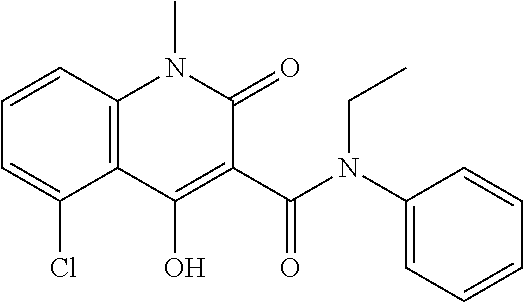Treatment of multiple sclerosis by alemtuzumab induction followed by laquinimod therapy
a technology of laquinimod and alemtuzumab, which is applied in the field of multiple sclerosis treatment by alemtuzumab induction followed by laquinimod therapy, can solve the problems of unsatisfactory clinical efficacy, the relationship between the changes in the immune response, and the number of potential side effects
- Summary
- Abstract
- Description
- Claims
- Application Information
AI Technical Summary
Benefits of technology
Problems solved by technology
Method used
Image
Examples
example 1
Assessment of Efficacy of Alemtuzumab Induction Therapy Followed by Laquinimod Maintenance Therapy in Multiple Sclerosis (MS) Patients
[0148]Periodic oral administration of laquinimod (p.o. 0.6 mg / day or 1.2 mg / day) as a maintenance therapy for a human patient afflicted with a form of MS who is undergoing or who has completed an induction therapy of alemtuzumab (IV 12 mg / day or 24 mg / day for at least 3 days or at least 5 days; The maintenance therapy begins on any day between Day 0 and Day 5 of the induction therapy, or any day up to Day 10 after the completion of the induction therapy) provides a clinically meaningful advantage and is more effective (provides at least an additive effect or more than an additive effect) in treating the patient than when each agent (at the same dose) is administered alone or when each therapy (at the same regimen) is employed alone.
[0149]The therapy also provides efficacy (provides at least an additive effect or more than an additive effect) in treati...
example 2
Assessment of Efficacy of Alemtuzumab Induction Therapy Followed by Laquinimod Maintenance Therapy in CIS Patients
[0162]Periodic oral administration of laquinimod (p.o. 0.6 mg / day or 1.2 mg / day) as a maintenance therapy for a human patient who is undergoing or who has completed an induction therapy of alemtuzumab (IV 12 mg / day or 24 mg / day for at least 3 days or at least 5 days; The maintenance therapy begins on any day between Day 0 and Day 5 of the induction therapy, or any day up to Day 10 after the completion of the induction therapy) provides a clinically meaningful advantage and is more effective (provides an additive effect or more than an additive effect) in delaying the conversion to clinically definite MS in patients presenting a CIS suggestive of MS than when each agent (at the same dose) is administered alone or when each therapy (at the same regimen) is employed alone.
[0163]Periodic oral administration of laquinimod (p.o. 0.6 mg / day or 1.2 mg / day) as a maintenance thera...
example 3
Assessment of Efficacy of CD52 Specific Antibody Induction Therapy Followed by Laquinimod Maintenance Therapy in Mice Models of Multiple Sclerosis
[0164]Laquinimod is periodically administered, as a maintenance therapy, to mice (models of MS, e.g., EAE), which have completed or are undergoing an induction therapy of a CD52 specific antibody (periodic administration for at least 3 days or at least 5 days). The maintenance therapy begins on any day between Day 0 and Day 5 of the induction therapy, or any day up to Day 10 after the completion of the induction therapy, and continues for a period of 1-96 weeks or more.
[0165]The CD52 specific antibody induction therapy followed by laquinimod maintenance therapy provides a clinically meaningful advantage and improved therapeutic efficacy (provides at least an additive effect or more than an additive effect) when compared with when each agent (at the same dose) is administered alone or when each therapy (at the same regimen) is employed alon...
PUM
| Property | Measurement | Unit |
|---|---|---|
| weight | aaaaa | aaaaa |
| weight | aaaaa | aaaaa |
| diameter | aaaaa | aaaaa |
Abstract
Description
Claims
Application Information
 Login to View More
Login to View More - R&D
- Intellectual Property
- Life Sciences
- Materials
- Tech Scout
- Unparalleled Data Quality
- Higher Quality Content
- 60% Fewer Hallucinations
Browse by: Latest US Patents, China's latest patents, Technical Efficacy Thesaurus, Application Domain, Technology Topic, Popular Technical Reports.
© 2025 PatSnap. All rights reserved.Legal|Privacy policy|Modern Slavery Act Transparency Statement|Sitemap|About US| Contact US: help@patsnap.com

